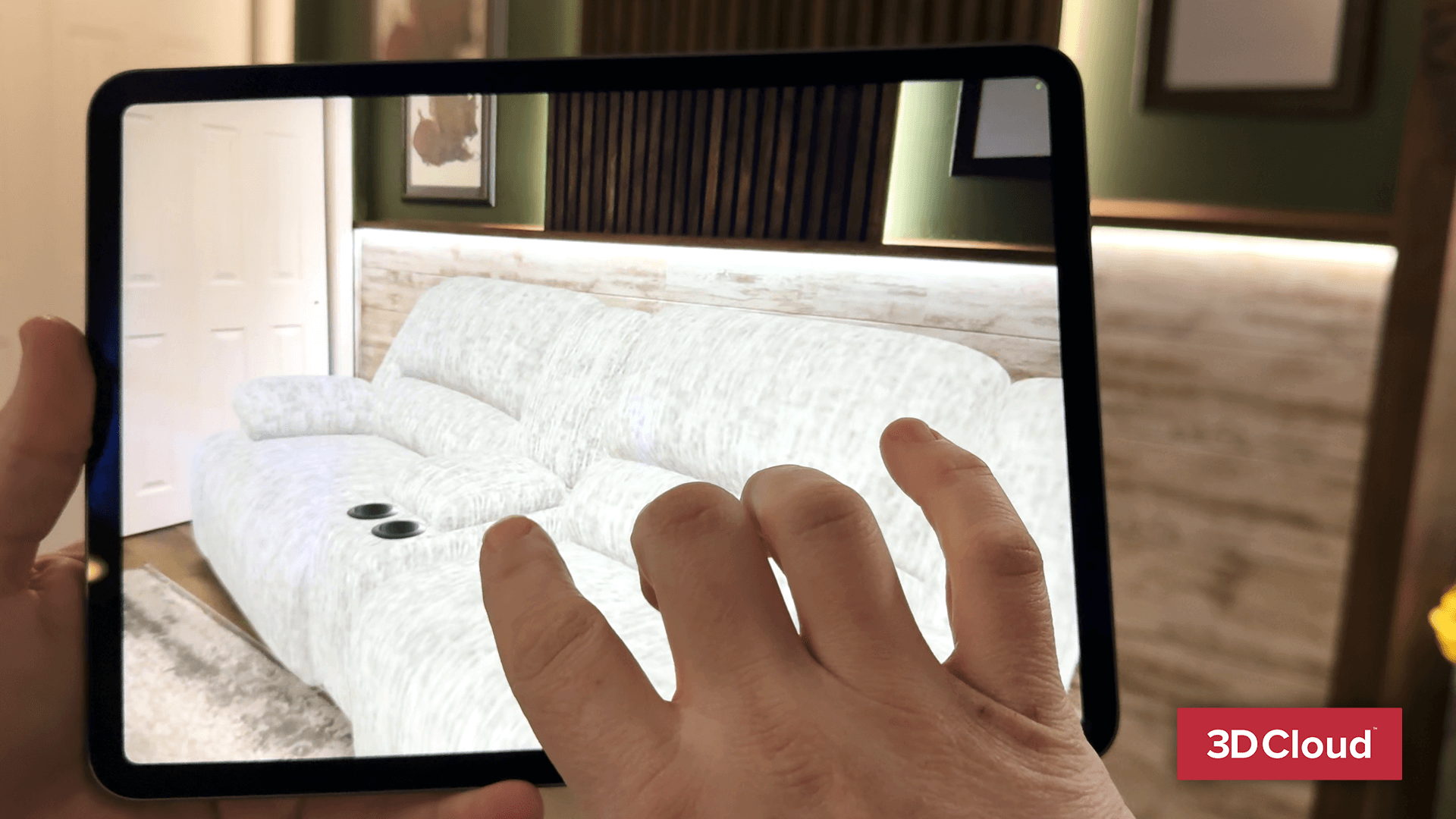
WebAR, or web-based augmented reality, is a relatively new technology that allows people to engage with AR elements directly in a web browser. We’ve rounded up the top 13 real-world examples of WebAR across fashion, education, healthcare, and other industries.
Inside this article:
What is WebAR?
WebAR stands for web-based augmented reality (AR). This emerging technology allows you to experience AR through a web browser. WebAR is an interactive AR experience that enhances the real world with a digital overlay.
Digital content can include text, images, 3D models, video, and audio. You don’t have to download a mobile app or use specific hardware to experience AR.
Why use WebAR?
The biggest reason for using WebAR is that it dramatically increases reach. Anyone with a smartphone can access AR elements through their mobile web browser, without needing to download a special app. This increases potential customer eyeballs on a company’s products.
WebAR creates a new and easier way to connect with users through interactive, immersive AR elements. For instance, a company can create lifelike digital models of their products or services, or create a virtual “try-on” experience for users to test the products.
WebAR provides benefits to both businesses and consumers. In fact, 68% of customers say they prefer retailers that offer this service. According to the 2021 Snap Consumer AR Global Report, using WebAR leads to a 94% higher conversion rate.
See below for a comprehensive list of the benefits of using WebAR.
WebAR examples by industry
Today, WebAR appears in diverse fields, from fashion and automotive to healthcare and education. Companies use WebAR to market their products, provide virtual “try-ons,” train surgeons, design buildings, and much more.
Experts predict that by 2025, 75% of smartphone users will be interacting with WebAR elements. This means that, regardless of your industry, investing in WebAR is worth it to stay ahead of the competition and showcase your products and services in a new, immersive way.
Below, we’ve gathered the most diverse recent examples of WebAR by industry, including fashion, retail, automotive, food and beverage, tourism, gaming, furniture, architecture, education, and healthcare. This roundup shows examples of companies using WebAR to streamline and refine their internal workflows, market their products, and create immersive experiences for the public.
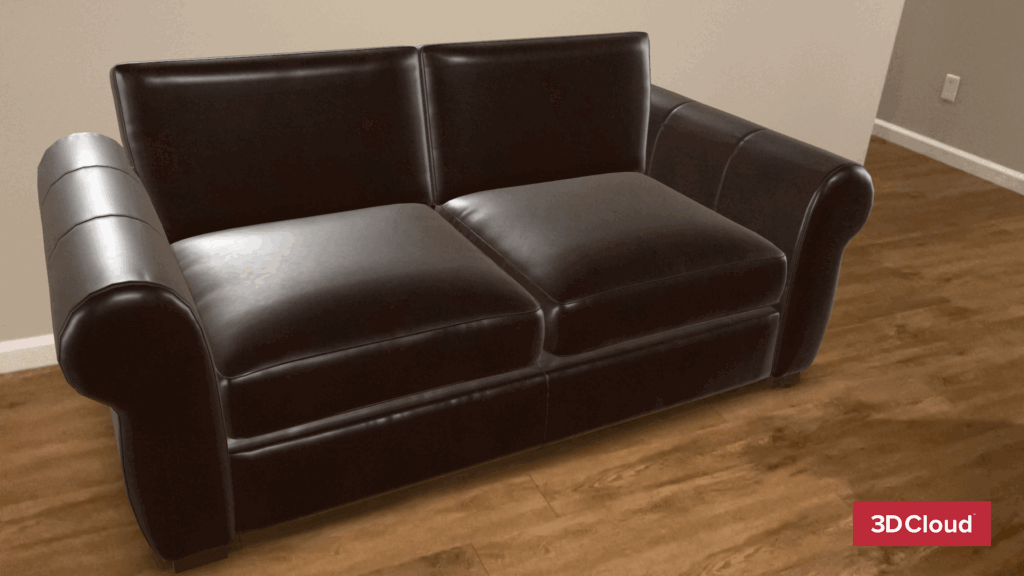
Jeromes WebAR
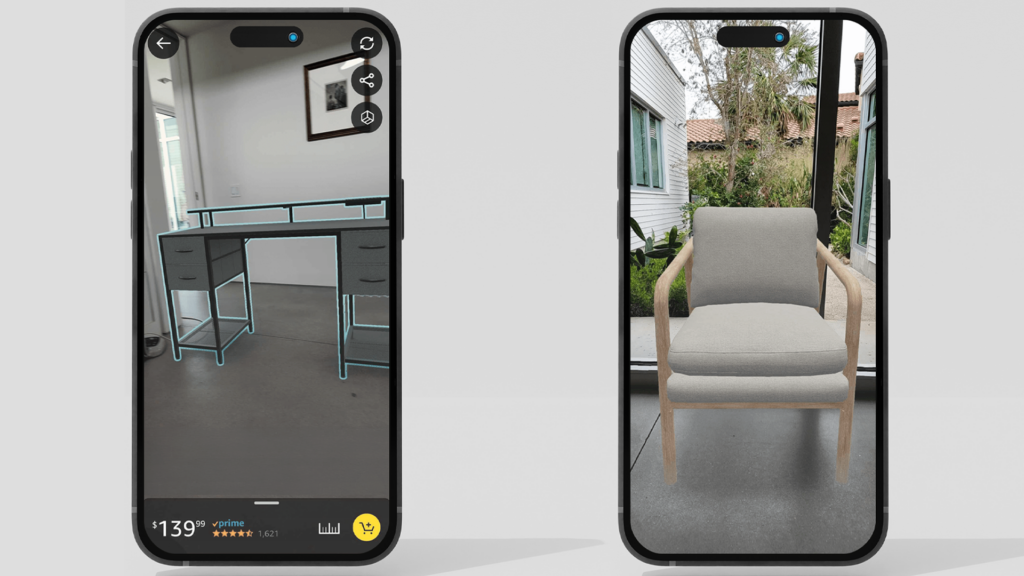
Amazon and Target WebAR
WebAR example in fashion: Khaite SS21 Lookbook
The fashion industry is a leader in using WebAR technology. In the past few years, they have experimented with virtual catwalks, AR 3D models of in-progress products, virtual fashion lines, and more.
The New York-based label Khaite previewed its Spring/Summer 2021 (SS21) lookbook using WebAR technology. Users scan a QR code with their phone and are directed to a web browser AR experience to visualize the upcoming line of Khaite shoes—including sandals, slingback heels, and low-heeled boots. Users can zoom in on or rotate each product to better understand how it will look and feel in real life.
Additionally, once users grant the browser camera access, they can place the shoes in their chosen real-world environments. Tap the image of each product and “place” it in your closet, on your foot, or elsewhere to see how it looks and fits.

Khaite SS21 Lookbook using WebAR
WebAR examples in furniture: IKEA, Jerome’s Furniture, Raymour & Flanigan, and DFS
On the heels of IKEA, in 2016, Jerome’s Furniture was the first U.S.-based regional furniture retailer to implement augmented reality. Since then, retailers like Raymour & Flanigan and DFS have implemented WebAR at enterprise scale. General merchandise retailers like Target and Amazon also offer WebAR on their mobile websites. Download the IKEA app to access products using WebAR.
Retailers using WebAR report tens of thousands of sessions per month. The technology increases time on site and conversion rate by up to 300% on mobile product page views.
WebAR example in retail: James Allen jewelry
Retail and e-commerce sites use WebAR technology to create virtual “try-on” experiences for online shoppers. One great example is the jeweler James Allen, who specializes in engagement rings and wedding bands.
Navigate to the James Allen website on any smartphone and select a ring. Click the “Try On” icon and upload or take a picture of your hand. An AR version of the ring will appear, allowing users to drag it to try it on. The experience also allows you to toggle between different diamond cuts (round, Princess, etc.) and save or share photos to find the perfect ring.
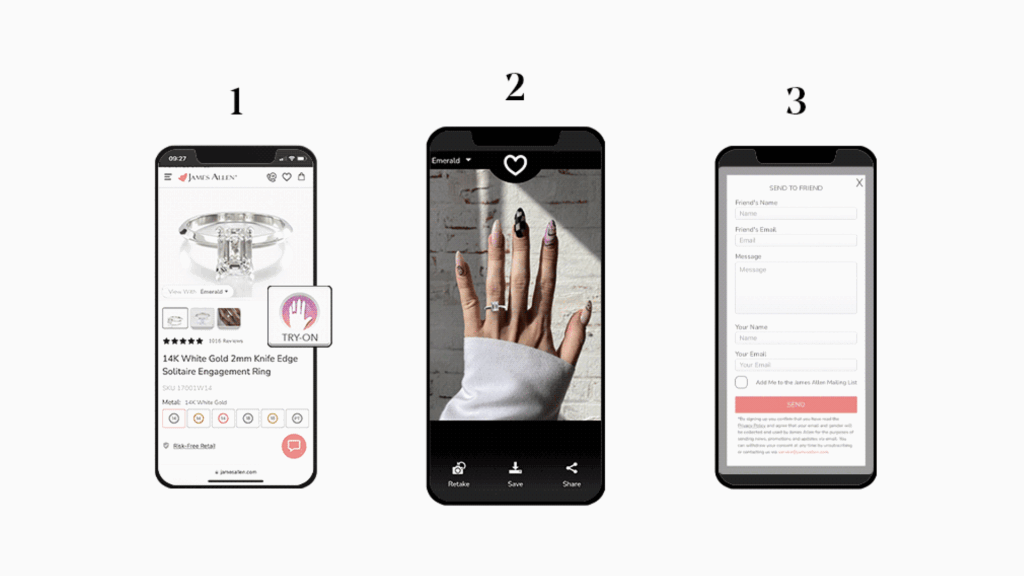
James Allen jewelry “try on” experience using WebAR
WebAR example in food and beverage: Moët & Chandon
In 2022, the fine wine company Moët & Chandon created a marketing campaign for its “Specially Yours” offering using WebAR. When customers bought a bottle of Champagne, the company sent it along with a virtual “delivery” AR animation. Using a web browser, customers could view a model of the bottle arriving in their living room, complete with limited-edition gift wrap, customized animations, emojis, and a personalized message.

Moet & Chandon “Specially Yours” offering using WebAR
WebAR example in the restaurant industry: Hard Rock International
Hard Rock International unveiled the “New Messi Chicken Sandwich” in 2023 as part of its partnership with soccer player Leo Messi. The marketing campaign incorporated WebAR to create an immersive virtual restaurant kitchen environment, allowing customers to explore and interact with various elements.
After scanning a QR code, customers were transported to the Hard Rock Café kitchen—made using WebAR—where they were “greeted” by Messi, played a trivia game, and gained access to limited-edition Instagram filters. Finally, viewers could watch an AR version of Messi as a chef creating the exclusive sandwich.

Hard Rock International Hard Rock Café kitchen experience using WebAR
WebAR example in the automotive industry: Ford
In 2023, Ford unveiled a new AR experience called “F-150 Lightning: Can Strike Anywhere”—available on any mobile browser. Ford estimates that 80 percent of existing customers have never owned an electric car before, so they wanted to create a heightened, immersive experience for people to preview the new F-150 Lightning model.
The environment includes animations of all variations of the electric pickup. Additionally, the AR function allows users to visualize the truck on their own street and interact with the different features to get a better sense of the model.
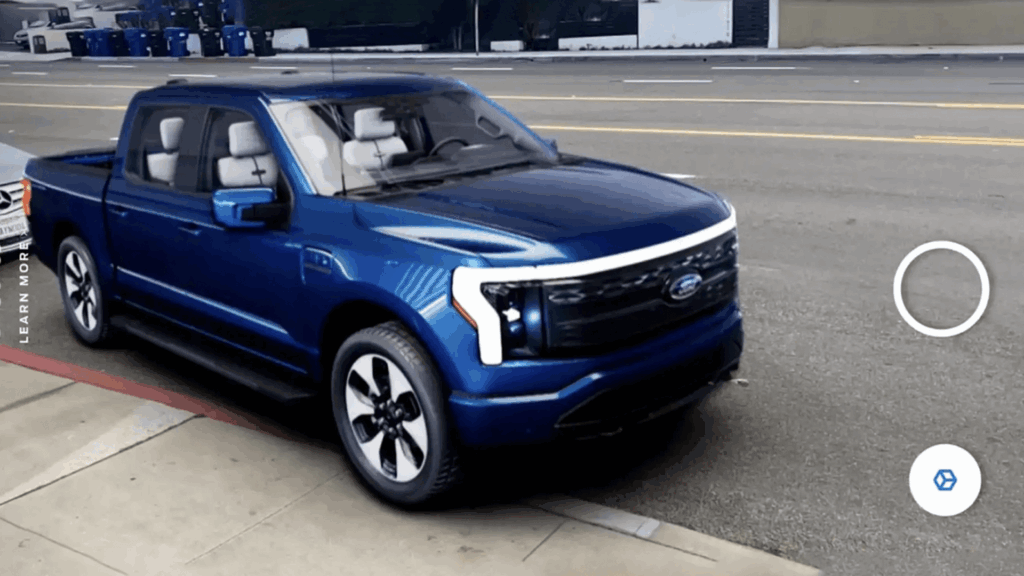
Fords’ AR experience “F-150 Lightning: Can Strike Anywhere”
WebAR example in a museum: The MET
In 2022, the Metropolitan Museum of Art (the MET) debuted an exhibit created in part with WebAR, called Chroma: Ancient Sculpture in Color. Using any smartphone, museum visitors can snap a picture of a sculpture in the MET’s collection and view it in a virtual environment where the original color has been restored.
Users could then tap the image to learn more about the sculpture’s history and download custom face filters related to the exhibit.

Metropolitan Museum of Art (the MET) exhibit Chroma: Ancient Sculpture in Color created in part with WebAR
WebAR example in gaming: Fortnite
AR has revolutionized the video game industry, leading to more immersive and lifelike environments for play. With WebAR, players can engage directly in the browser in both single and multiplayer modes. The technology also picks up the human player’s gestures without additional hardware, so players can move their arms to control their character’s movements.
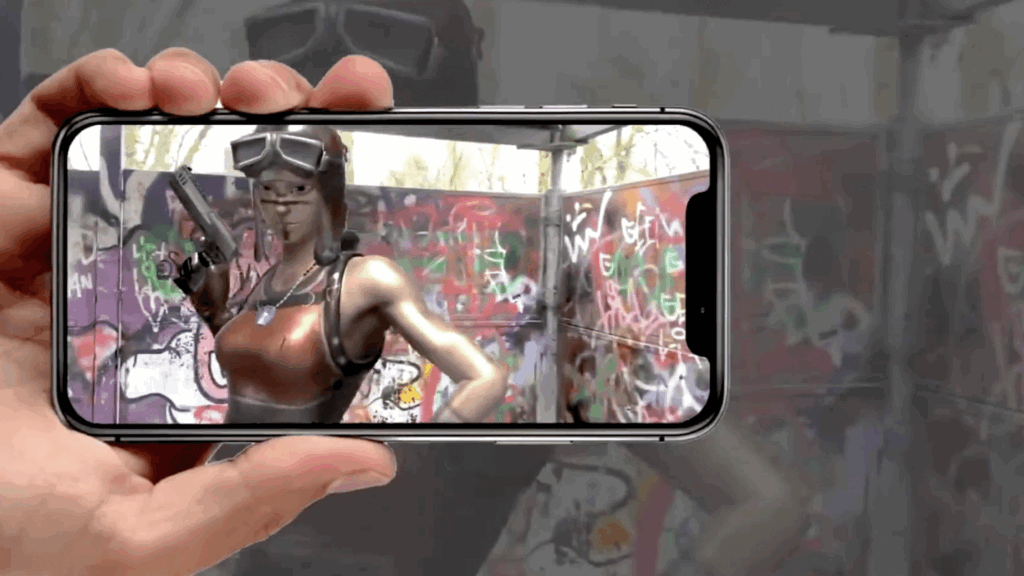
Fortnite WebAR gaming
WebAR example in entertainment: Sony Pictures’ Spiderman: Into the Spiderverse
In 2018, Sony announced one of the most cutting-edge WebAR examples to date as part of the promotion for Spiderman: Into the Spiderverse. Fans can “enter” and explore the Spiderman world directly from their mobile browser without downloading a special app. The technology also leveraged Amazon Web Services’ tool, the web-based content editor Amazon Sumerian, released the previous year.
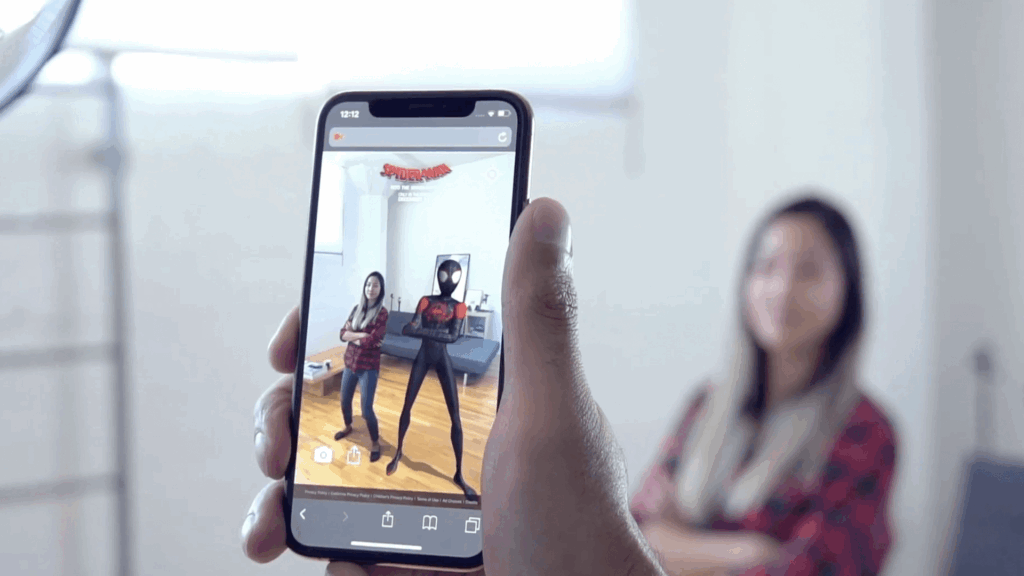
Sony Pictures’ Spiderman: Into the Spiderverse WebAR experience
WebAR example in education: Tikrit University
Classrooms around the world are introducing WebAR to increase engagement and access to education. The past few years have seen a rise in interactive experiences, such as games and quizzes with 3D visuals and 360-degree videos, as well as WebAR-powered immersive field trips. This technology is especially helpful as remote learning becomes more common.
A 2023 study published by Tikrit University found that WebAR tools are especially useful when teaching a foreign language, in this case, English. “In teaching English, WebAR technology helps pupils to improve their achievement and can create an enjoyable atmosphere and break classroom boredom,” the study’s conclusion reads. “Using WebAR technology enables non-native pupils to listen to the pronunciation of the presented material and see it simultaneously.”

Tikrit University found that WebAR tools are especially useful when teaching a foreign language
WebAR example in healthcare: NYU Grossman School of Medicine
The healthcare industry has slowly introduced virtual and augmented reality technologies, and WebAR makes it easier for medical professionals to practice skills virtually. In 2024, the healthcare industry is leveraging WebAR technology for remote training and telemedicine, for example, for showing a 3D model of an internal illness.
One huge breakthrough is the use of WebAR for surgical simulations. A 2023 study published by the NYU Grossman School of Medicine found that WebAR technologies “can significantly improve surgical skill acquisition and confidence among medical professionals. It addresses the critical issue of medical errors by allowing trainees to practice in a safe and controlled environment before transitioning to real-life cases.” Experts predict surgeons will begin using WebAR overlays in real surgeries, too.
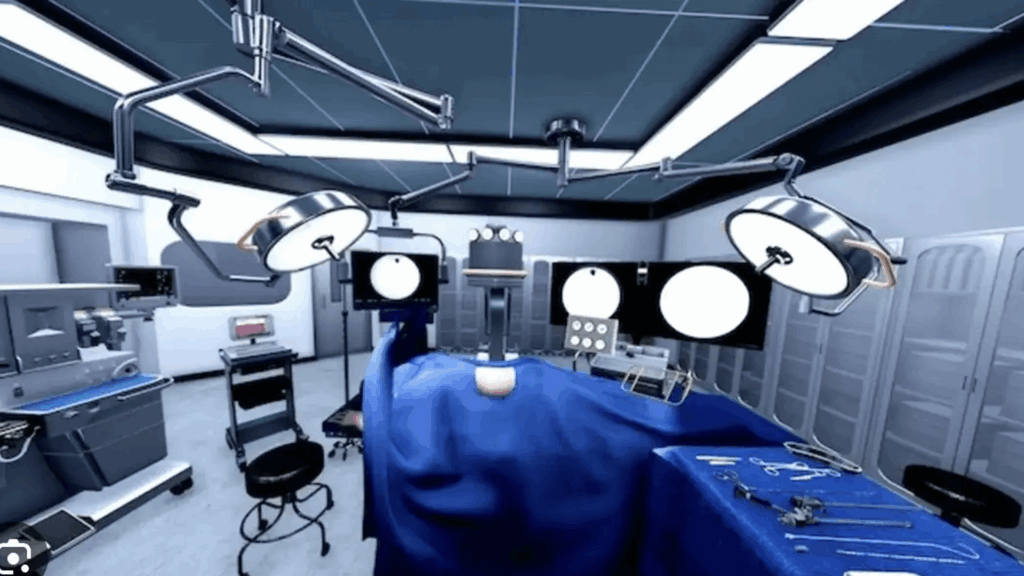
NYU Grossman School of Medicine using WebAR for surgical simulations
WebAR example in tourism: Visit Portland Experience
In 2023, Augmented Studios for Travel used WebAR to produce the one-of-a-kind Visit Portland Experience. Users scanned a QR code found on print materials and were transported to an in-browser AR experience to explore the city, learn about the creative and natural sites, and even follow the city’s beloved Sasquatch mascot on a guided tour.

Augmented Studios for Travel used WebAR for their Visit Portland Experience
WebAR Example in architecture: UNESCO World Capital of Architecture
By eliminating the need for dedicated custom applications, WebAR makes it easier for architecture and construction firms of all sizes to integrate AR into their existing workflows. This is important because, as Autodesk reported, firms see 30% fewer design errors when using AR.
WebAR is commonly used for visualizations and simulations for architects and contractors. This allows them to see the full build sequence on a web browser before breaking ground. In the future, WebAR will likely provide on-site guidance, too. One great example of WebAR in architecture is the virtual environment produced by UNESCO for the World Capital of Architecture conference in Copenhagen in 2023. In this environment, users could take virtual and real-time tours of the city and its plans.

UNESCO World Capital of Architectures’ uses WebAR for visualizations and simulations for architects and contractors
Benefits of using WebAR
The biggest benefits of WebAR are greater reach and ease of use. WebAR is much easier to build, distribute, access, upgrade, and report on, so it vastly increases the potential audience.
Below are the main benefits of using WebAR vs. app-based AR:
- Greater reach: The primary benefit of WebAR is broader access to AR—which means greater reach to potential customers. In the past, AR was available only to customers willing to download the retailer’s app. Now, with WebAR, it’s available to anyone who visits the retailer’s website. In turn, this greatly increases the potential customer base.
- Ease of use: WebAR doesn’t require users to download and install a mobile application or use any additional hardware or software. Instead, users can engage with the AR features directly in a web browser.
- WebAR is operating system (OS) agnostic: This means it works across different devices and platforms from within a web browser, so developers don’t have to create unique iOS and Android versions.
- Ease of distribution: Share WebAR content by embedding a hyperlink or adding a QR code across other websites and all social media platforms.
- More granular insights: It’s possible to track customer engagement metrics through more sophisticated web analytics, such as the time a user spends interacting with a particular product.
- Quicker time to market: WebAR is much faster and easier to deploy than app-based AR, which has to be submitted to the App Store for approval.
- Easier maintenance and upgrades: It is much easier to monitor and upgrade WebAR vs. app-based AR.
What is the future of WebAR?
The future of WebAR will move in sync with the Web 3.0 movement and improved technology in mobile devices and 5G. WebAR will become more common across industries, fueling more investment and innovation in WebAR technology itself.
Below are some of the top innovations we can expect from WebAR in the future:
- Machine learning algorithms and artificial intelligence: In this next innovation phase, more connected devices using advanced machine learning (ML) algorithms and artificial intelligence (AI) applications will empower more interactive 3D AR experiences.
- Virtual try-on: Many e-commerce platforms are experimenting with virtual “try-on” options within their websites. This transforms online shopping from a more passive browsing experience to an interactive experience that more closely resembles in-person shopping.
- AR advertising: Augmented reality ads are becoming increasingly prevalent across industries, from TV and movie promotion to standard consumer product ads. AR makes ads much more stimulating and immersive, and with WebAR, users can access them directly from a web browser.
- Filters: This includes face and hair filters already popular on Instagram, Snapchat, and TikTok, as well as background replacement, virtual 3D objects, and AR-generated sound and graphics.
- Indoor/outdoor navigation: WebAR is poised to replace standard GPS and map applications and offer seamless navigational support with clear directions overlaid on the screen.
- Immersive gaming: In this context, WebAR presents a 3D environment that users can interact with freely. Some gaming platforms, such as Fortnite and Roblox, have already implemented this technology.
- 5G: WebAR technology will continue to become more accessible in part due to the spread of 5G, which is faster and more accessible due to decreased load time.
- Virtual events: While virtual events have already become popular in the past several years, WebAR will make them even more interactive and engaging.
What is WebAR OnDemand?
WebAR OnDemand is the “app-less” augmented reality and product configuration technology offered exclusively by 3D Cloud. It refers to a responsive web app that empowers users to design and create on-demand digital 3D elements for products with thousands or millions of variants. Their unique configurations can then be downloaded and shared, offering a range of ways to visualize products in any given space.
WebAR OnDemand technology removes the need for preconfigured 3D models and allows retailers to offer an AR experience for every product variant at scale.
WebAR OnDemand from 3D Cloud
Businesses need to leverage WebAR capabilities in their marketing and e-commerce efforts to maximize customer reach and increase conversion. This is especially important for companies that sell highly configurable products, as customers can see how they look and fit in a lifelike, virtual environment.
WebAR OnDemand from 3D Cloud provides web-based AR with unlimited variants for configurable products—directly within a web or mobile browser. This combines 3D Cloud’s Product Configurator with WebAR to produce a premium online retail experience so companies can deploy the latest technology to increase reach and drive sales.










